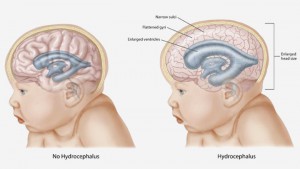DEFINITION
It is a condition in which an accumulation of cerebrospinal fluid (CSF) occurs within the brain .This causes increased pressure inside the skull
SYMPTOMS
Babies:
- Rapid head growth
- vomiting
- sleepiness
- seizures
- Downward pointing of eyes
Adults
- Headache
- Double vision
- Poor balance
- Urinary incontinence
- Personality changes
- Mental impairment
- Sleepiness
CAUSES
- Too much CSF is produced
- One of the ventricles in brain is blocked or narrowed, stopping or restricting the flow of CSF so that it cannot leave the brain
- CSF cannot filter into the blood stream
Congenital hydrocephalus
- CMV
- German measles
- Mumps
- Syphilis
- Taxoplasmosis
Acquired hydrocephalus
- Brain hemorrhage
- Brain lesions
- Brain tumors
- Meningitis
- Stroke
TYPES
- Congenital Hydrocephalus: It is one of the most common developmental disabilities , more common than Down’s Syndrome or deafness. It may be caused by an infection in the mother during pregnancy such as rubella, or mumps or a birth defect such as spina bifida
- Acquired Hydrocephalus: This develops after birth, usually after a stroke , brain tumor , meningitis etc
- Communicating Hydrocephalus: This type occurs when the CSF becomes blocked after leaving the ventricles. It is called communicating because CSF can still flow between the brain ventricles
- Non communicating: Also called Obstructive hydrocephalus occurs when the thin connections between the ventricles become blocked
RISK FACTORS
- Premature birth infants born preterm have a higher risk of intraventricular hemorrhage or bleeding within the ventricles of the brain which may result in hydrocephalus
- Problems during pregnancy
- Problems with fetal development, cord or brain
- Infections of the nervous system
- Bleeding in the brain
- Severe head injury
TREATMENT
One of two surgical treatments may be used to treat hydrocephalus
SHUNT:
The most common treatment of hydrocephalus is the surgical insertion of a drainage system , called shunt. It consists of a long flexible tube with a valve that keeps fluid from the brain flowing in the right direction and at the proper rate. One of the tubing is usually placed in one of the brains ventricles. The tubing is then tunneled under the skin to another part of the body where the excess CSF can more easily absorbed
ENDOSCOPIC THIRD VENTRICULOSTOMY:
It is a surgical procedure , in which your surgeon uses a small video camera to have direct vision inside the brain. Your surgeon makes a hole in the bottom of the one of the ventricles or between the ventricles to enable CSF to flow out of the brain
To get opinion from our network of hospitals visit www.mvtbooking.com or send email to query@gtsmeditour.com
Prepared by :Dr Sajna Hamza


Post a comment